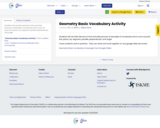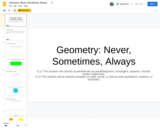
The Pythagorean Relationship Mathematics Instructional Plan
- Subject:
- Mathematics
- Measurement and Geometry
- Material Type:
- Lesson Plan
- Provider:
- VDOE
- Author:
- VDOE
- Date Added:
- 10/07/2024

The Pythagorean Relationship Mathematics Instructional Plan

Special Right Triangles and Right Triangle Trigonometry Mathematics Instructional Plan

Properties of Quadrilaterals Mathematics Instructional Plan

This is a project for geometry students after they have completed their unit on parallel lines and angles formed by parallel lines and transversals. This project involves creativity and artistic expression.

Students will use their devices to find and take pictures of examples of vocabulary terms such as point, line, plane, ray, segment, parallel, perpendicular, and angle.

This resource is a series of Google Slides that asks if two attributes of quadrilaterals and triangles can exist together 'Never, Sometimes, or Always.' After posing the question, the following slide will show the an and possible examples of the given polygons.

Mathematics Vocabulary Word Wall Cards

Identify, describe, and represent points, lines, line segments, rays, angles, and intersecting, parallel, and perpendicular lines. Mathematics Instructional Plans (MIPs) help teachers align instruction with the Mathematics Standards of Learning (SOL) by providing examples of how the knowledge, skills and processes found in the SOL and curriculum framework can be presented to students in the classroom.

In Unit 5, students explore concepts of perimeter and geometry. Students have gradually built their understanding of geometric concepts since Kindergarten, when students learn to name shapes regardless of size and orientation. They also learn to distinguish between flat and solid shapes. In Grade 1, students’ understanding grows more nuanced, as they learn to distinguish between defining and non-defining attributes, as well as compose and decompose both flat and solid shapes. In Grade 2, students draw and identify shapes with specific attributes. All of this understanding gets them ready for Grade 3, in which students begin their journey of measuring those attributes, including area (addressed in Unit 4), and perimeter (explored here), as well as classification of shapes based on attributes into one or more categories.
Students begin the unit by defining perimeter as the boundary of a two-dimensional shape and measure it by finding its length. For a polygon, the length of the perimeter is the sum of the lengths of the sides. They develop their understanding of perimeter by measuring it with a ruler, finding it when all side lengths are labeled, and then finding it when some information about the length of a shape’s side lengths needs to be deduced, such as when a rectangle only has its length and width labeled. Students then solve real-world and mathematical problems, both given a figure and without one, involving perimeters of polygons (3.MD.8). With this understanding of perimeter, they are able to compare the measurement of area and perimeter of a rectangle, seeing that a rectangle with a certain area can have a variety of perimeters and, conversely, a rectangle with a certain perimeter can have a variety of areas, connecting the additional cluster content of perimeter to the major cluster content of area. Students then solve various problems involving area and perimeter. The last topic of the unit explores geometry. Students build on Grade 2 ideas about polygons and their properties, specifically developing and expanding their knowledge of quadrilaterals. They explore the attributes of quadrilaterals and classify examples into various categories (3.G.1), then explore attributes of polygons and classify examples into various categories, now including quadrilaterals. Students also draw polygons based on their attributes. Students next use tetrominoes and tangrams to compose and decompose shapes.
In this unit, students reason abstractly and quantitatively, translating back and forth between figures and equations in the context of perimeter problems (MP.2). Students will also construct viable arguments and critique the reasoning of others as they develop a nuanced understanding of the difference between area and perimeter, as well as when they classify shapes according to their attributes and justify their rationale (MP.3). Lastly, students will use appropriate tools strategically by using rulers to measure the side lengths of polygons to find their perimeter, as well as use rulers and right angle templates to find attributes of shapes to determine their classification (MP.5).

In Unit 3, students will explore volume of three-dimensional shapes (5.MD.3—5), connecting it to the operations of multiplication and addition (5.NBT.5, 4.NBT.4). They also use their understanding that they gradually built in prior grade levels to classify shapes in a hierarchy, seeing that attributes of shapes in one category belong to shapes in all subcategories of that category (5.G.3—4).
This unit builds off of students’ well-established understanding of geometry and geometric measurement. Similar to students’ work with area, students develop an understanding of volume as an attribute of solid figures (5.MD.3) and measure it by counting unit cubes (5.MD.4). Students then connect volume to the operation of multiplication of length, width, and height or of the area of the base and the height and to the operation of addition to find composite area (5.MD.5). Throughout Topic A, students have an opportunity to use appropriate tools strategically (MP.5) and make use of structure of three-dimensional figures (MP.7) to draw conclusions about how to find the volume of a figure.
Students then move on to classifying shapes into categories and see that attributes belonging to shapes in one category are shared by all subcategories of that category (5.G.3). This allows students to create a hierarchy of shapes over the course of many days (5.G.4). Throughout this topic, students use appropriate tools strategically (MP.5) to verify various attributes of shapes including their angle measure and presence of parallel or perpendicular lines, as well as attend to precision in their use of language when referring to geometric figures (MP.6). They also look for and make use of structure to construct a hierarchy based on properties (MP.7).

Just in Time Quick Check Geometry and Symbolic Notation

Just in Time Quick Check Determining Area of a Sector

Just in Time Quick Check Angles of Convex Polygons

Just in Time Quick Check Number of Sides of a Regular Polygon

Just in Time Quick Check Practical Problems With Properties of Circles

Just in Time Quick Check Properties of Circles

Just in Time Quick Check Determining Arc Length

Just in Time Quick Check Equations of Circles

Just in Time Quick Check Surface Area and Volume of Three-Dimensional Objects

Just in Time Quick Check Comparing Ratios Between Lengths, Perimeters, Areas and Volumes of Similar Figures